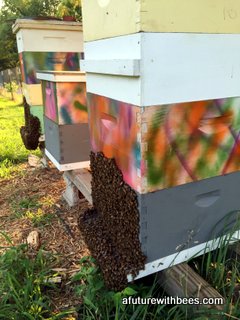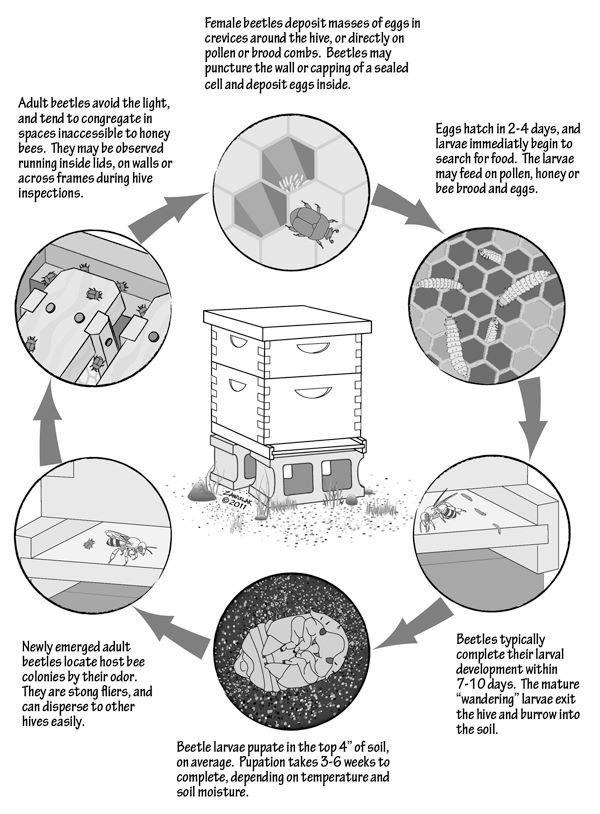July is normally a hot, dry month here in the Ozarks. The population in most hives has reached its peak and will slowly start to decline by the end of July because the main nectar flow is over. July and August see very little nectar coming into the hives. From what I’ve experienced, there is just enough nectar for them to maintain their reserves but not enough to gain significantly. (Although keeping a hive on a scale shows some very interesting ups and downs).
Swarming season is over unless hives are left with too little space and are severely congested. As things start to slow down, my hive inspections are reduced. If there is adequate room on the hive, I only check them about every 3 weeks in July. By August, I am only checking them about once a month.
Mistakes I’ve made:
- Adding more boxes/supers on hives when they have not drawn out the frames in the lower boxes first. If I add mediums onto a hive, and they have not drawn out the deep frames, then I end up with a lot of drawn medium frames but not enough deep frames to winter the bees well (because bees work at the top). Make sure the deep frames are well drawn before adding medium boxes on a hive (this is most important for newer hives).
- Comb manipulation – Old combs left in the brood area are hard to cycle out of the operation be-cause they are always filled with brood. I’ve learned to put the older combs up and to the outside so they are filled with honey instead of brood. When filled with honey, we can pull them and replace them with newer combs. Then we extract them and use them for fire starters and crafts.
- I’ve learned to stop adding foundation by mid-July. Most hives will stop drawing foundation in early July after the main nectar flow slows. They will walk all over foundation and chew holes it, but most hives will not draw it. A few hives will draw it. Make sure you note in your records which hives still draw foundation in July. (Records are one of your most important management tools!!)
- For those of you making splits or raising queens; I’ve learned that I can’t make small nucs when it is hot. When the nectar flow stops, the older hives start looking for easy targets and my nucs get robbed out. I’ve learned to make strong nucs for rearing queens in late summer. (Pretty much I’ve learned to stop making weak nucs at all. Too much trouble, not enough success.)
- Small Hive Beetle (SHB) populations peak in July and August. I hardly see any of these danged creatures in May and June. Then Bam! All of the sudden they are everywhere. Fortunately, the bees handle them all by themselves. A dozen small hive beetles does not mean my hive is in trouble – it is a normal state of affairs in this day and age. There is no effective control of SHB other than keeping colonies strong and robust. Beetle traps may add some assistance but they do not control SHB. Any pesticides which would harm beetles will severely harm the bees as well – please don’t fall for that misguided thinking! I know you are trying to help, but really, the bees take care of the problem quite easily without us making it harder.
- It is important to reduce the number of hive inspections because the bees imprison the SHB in prisons made of propolis. These “prisons” are usually made between the side bar of the frames and the side wall of the hive. When we move or pull the frames during inspections, we break the prison walls and allow the SHB’s to escape. Then the bees have to spend a lot of energy chasing them down again. Wasted Energy! I’ve learned to reduce hive inspections in late July and August and to be careful not to “jail break” the SHB!
- SHB will not destroy a good hive. If a colony is so weak that beetles can establish a foothold and start breeding larvae, then there was something wrong with that hive weeks ago. SHB and wax moths are exploiters of weak hives, not destroyers of good hives. If a hive is weak, figure out why and fix it. Don’t try to nurse it along until it declines and becomes a source of infection or a breeding ground for SHB or wax moths.
Mistakes I’ve heard:
- I get calls every year from bee-keepers who think their hive is swarming. Swarming is a swirling mass of bees flying about the hive, not a dense “beard” of bees hanging around the entrance to stay cooler. When it gets hot bees hang out on the entrance – yes literally hang out – to stay cooler. This “bearding” does not mean swarming. It means it is hot inside the hive.
I hope that sharing the mistakes I’ve made, and some of the common mistakes I see, will help you avoid them!

